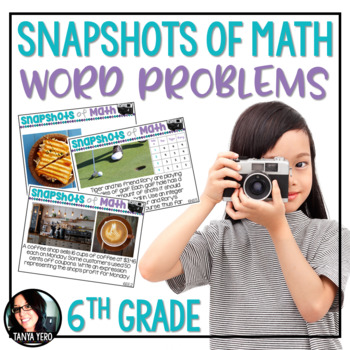6th Grade Math Word Problems Spiral Review
- Zip
- Google Apps™

What educators are saying
Description
Visual representation is important to students. Get your students excited about math by using Snapshots of Math Word Problems!
This purchase contains word problems for all the 6th grade math standards. Each word problem is applicable for learners and includes a photo for visual representation. Each question is on a PowerPoint slide for easy use and can be used during a whole group lesson, to introduce a skill, or extra practice.
Check out the preview for a peek into this product
Standards and Topics Covered
Ratios and Proportional Relationships
➥ 6.RP.1 – Understanding ratios
➥ 6.RP.2 –Understanding unit rates associated with a ratio
➥ 6.RP.3 – Use ratio and rate reasoning to solve real world problems
The Number System
➥ 6.NS.1 - Interpreting and commuting quotients of fractions
➥ 6.NS.2 – Fluently divide multi-digits numbers
➥ 6.NS.3 – Fluently add, subtract, multiply, and divide
➥ 6.NS.4 – Finding the greatest common factor of two numbers
➥ 6.NS.5 – Understanding positive and negative numbers
➥ 6.NS.6 – Understanding a rational number as a point on a number line
➥ 6.NS.7 – Ordering absolute value of rational numbers
➥ 6.NS.8 – Solve real world problems by graphing points on a coordinate plane
Expressions and Equations
➥ 6.EE.1 – Write and evaluate numerical expressions involving exponents
➥ 6.EE.2 – Write, read, and evaluate expressions using variables
➥ 6.EE.3 - Apply the properties of operations to generate equivalent expressions.
➥ 6.EE.4 - Identify when two expressions are equivalent
➥ 6.EE.5 - Understand solving an equation or inequality as a process of answering a question:
➥ 6.EE.6 - Use variables to represent numbers and write expressions when solving a real-world or mathematical problem
➥ 6.EE.7 - Solve real-world and mathematical problems by writing and solving equations
➥ 6.EE.8 – Writing inequalities
➥ 6.EE.9 – Using variables to represent two quantities in real world problems
Geometry
➥ 6.G.1 – Finding area of triangles
➥ 6.G.2 – Finding volume of prisms with fractional length amounts
➥ 6.G.3 – Drawing polygons on a coordinate plane
➥ 6.G.4 - Represent three-dimensional figures using nets made up of rectangles and triangles
Statistics and Probability
➥ 6.SP.1 – Recognize statistical questions
➥ 6.SP.2 - Understand that a set of data collected to answer a statistical question has a distribution,
➥ 6.SP.3 – Measuring the center of data
➥ 6.SP.4 - Display numerical data in plots on a number line, including dot plots, histograms, and box plots.
➥ 6.SP.5 – Summarize numerical data sets


